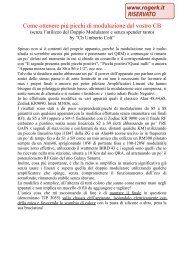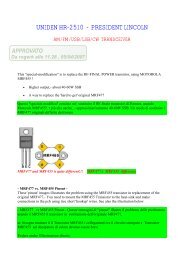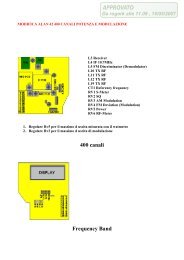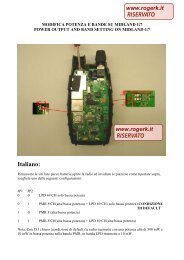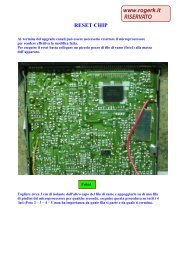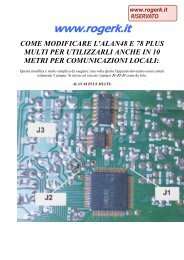Modifications for the ICOM - RogerK
Modifications for the ICOM - RogerK
Modifications for the ICOM - RogerK
- No tags were found...
You also want an ePaper? Increase the reach of your titles
YUMPU automatically turns print PDFs into web optimized ePapers that Google loves.
The Yaesu FT726R first appeared ten years ago, <strong>the</strong> FT736R six, so <strong>the</strong> operational needs of satellite operators are wellestablished. Why have Icom made such heavy wea<strong>the</strong>r of it?Preamplifiers & Linear AmpsYou can send +10v up ei<strong>the</strong>r, both or nei<strong>the</strong>r of <strong>the</strong> VHF/UHF antenna sockets. This supply is removed from <strong>the</strong> relevant socketon transmit.The manual does not specify a maximum loading; I tried 100 ma and 200 ma and <strong>the</strong> voltage remained steady; at 330 ma itbegan to droop. The limit is set by dissipation in a PQ20VZ51 regulator on <strong>the</strong> display unit.O<strong>the</strong>r than this 10v supply, <strong>the</strong>re is no provision <strong>for</strong> hard switching of pre-amplifiers or linear amplifiers unless you confineyourself to one band, when you can of course use <strong>the</strong> PTT line via <strong>the</strong> accessory socket. Serious operators will regret thisomission. In contrast, <strong>the</strong> Yaesu FT736R has four control lines, one <strong>for</strong> each band.Internal TX/RX changeover is by PIN diodes, so it's fast and silent.RF Power ControlThe front panel sports a high/low power control button. Low power is 4-5 watts.If you have an external linear amplifier or a transverter you need to be able to vary <strong>the</strong> output power continuously. There is noknob provided <strong>for</strong> this.There is instead an ALC facility on <strong>the</strong> accessory socket. The control voltage is -4 to 0 volts into "more than 10K", but you mustprovide a supply and a pot to do this. And a box, and a place to put it. Tacky. There's some free space on <strong>the</strong> rear panel though...There are several ways to key this transmitter; <strong>the</strong>re's <strong>the</strong> Tone button, mixed in with o<strong>the</strong>r frequently used buttons and easilyhit. Then <strong>the</strong>re's <strong>the</strong> bigger Transmit button, and <strong>the</strong> normal PTT (mic or TNC). More than once I accidentally hit <strong>the</strong> Tonebutton, sending a minimum of 4 watts skywards. That would have wiped out my S-band converter had it been connected.RF AttenuatorsYou can attenuate <strong>the</strong> RF input of ei<strong>the</strong>r or both receivers, by 15db, from a front panel button. This is in lieu of a (big) RF Gainknob, and an is excellent feature. Many preamplifiers have far too much gain; an S-band pre-amp plus converter most certainlydoes. Being able to cut <strong>the</strong> signal down to size prevents cross modulation and overloading.Digital Satellite/Terrestrial OperationBe<strong>for</strong>e describing this, it's necessary to tell you how <strong>the</strong> data input and output audio is routed, because it is not unconditional.You might like to draw yourself a little sketch.Both signals are presented to <strong>the</strong> 8-pin DIN Accessory socket on <strong>the</strong> rear panel.The incoming transmit audio (TXAudio) passes though a slider switch marked PACT/AMOD :●●In <strong>the</strong> AMOD position <strong>the</strong> TXAudio passes to <strong>the</strong> Main subsystem where it meets up with <strong>the</strong> regular pre-amplifiedmicrophone sound <strong>for</strong> use in FM or SSB modes, and <strong>the</strong>n through some audio processing.In <strong>the</strong> PACT position <strong>the</strong> audio goes directly to <strong>the</strong> varactor diode of Main's FM section.The receive audio (RXAudio) also passes through <strong>the</strong> PACT/AMOD slider switch:●●In <strong>the</strong> AMOD position, RXAudio is picked up from ei<strong>the</strong>r <strong>the</strong> Main or Sub receiver, according to <strong>the</strong> setting of ano<strong>the</strong>rinternal slider switch marked MAAF/SAAF, and is squelched.In <strong>the</strong> PACT position <strong>the</strong> audio is collected directly from <strong>the</strong> discriminator of <strong>the</strong> Main FM circuit, via a 4k7 resistor and100nf coupling capacitor. It's unsquelched of course.These switches are not accessible without removing <strong>the</strong> bottom cover. An access hole could surely have been placed next to <strong>the</strong>accessory socket, which would allow <strong>the</strong>se switches to be tickled with a small screwdriver. Users will probably drill a couple ofholes in <strong>the</strong> bottom, or cut away some of <strong>the</strong> underside ventilation grille.But why should you need to touch <strong>the</strong>m at all? Read on ...1200 bps PSK SatellitesFO-20, PacSat, Lusat and Weber require an FM uplink, to which is applied audio PSK. The downlink is conventional carrier PSK,and <strong>the</strong> system is full duplex. There<strong>for</strong>e <strong>the</strong> internal switches must be set to AMOD and SAAF (see above).The uplink "eye" as received at <strong>the</strong> satellite is OK; it's pinched about 4 db. Remember <strong>the</strong> TXAudio has been through <strong>the</strong> regularFM modulator circuits. It's a good idea not to yell into <strong>the</strong> microphone at this time, unless <strong>the</strong> Mic gain pot is at minimum, sinceboth signals are added. If you flip <strong>the</strong> MOD switch to PACT <strong>the</strong> uplink modulation is text-book perfect, but <strong>the</strong>n you lose your




